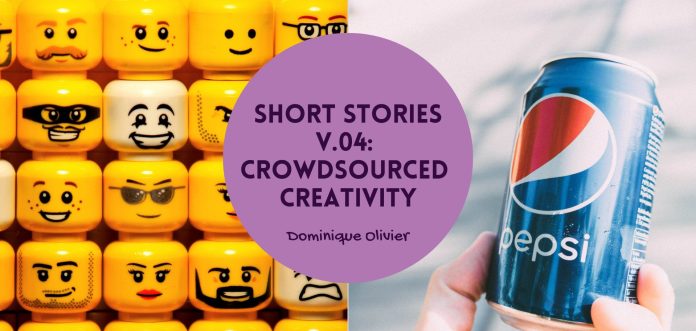Every so often, I come across a story that I think would work well for this audience, only to find that it is actually just too light to justify a full article. Never one to deny you informative (and interesting) content, I’ve decided to alternate my usual long writing format with the occasional collection of short stories, tied together by a central thread but otherwise distinct from each other.
Many of us are sitting on a treasure trove of inventions that we’re sure would be hits if we just had the chance to pitch them. But does that mean all of those ideas are worth investing in? In v.04 of my Short Stories, I’m bringing you a handful of examples of what happens when big brands turn to their customers for ideas. Customer concepts meet big brand money – could this be a winning recipe?
Lego Ideas
Lego Ideas is essentially a dream factory for Lego enthusiasts. It’s a platform run by The Lego Group and Chaordix that lets fans submit their own ideas for Lego sets. If a project gets enough love (10,000 supporters, to be exact), it could become a real, official Lego set, with the creator earning 1% of the royalties. Pretty sweet for something built out of little plastic bricks!
This all started back in 2008 as a spinoff from a Japanese company called Cuusoo (which means “fantasy” in Japanese). The process is simple: you submit a description and a Lego model of your idea on the Lego Ideas website, and if your project gets enough votes from other Lego enthusiasts, it gets a shot at being reviewed by Lego for production. In the early days, there were no real limits on submissions – anything and everything was fair game, from massive builds to complex concepts. But over time, Lego set a few ground rules: no new part moulds, no adult content, no life-size weapons, and no sets based on properties they already produce (sorry, Star Wars and Harry Potter fans).
While 10,000 votes might sound like a golden ticket, it’s not a guaranteed win. Plenty of projects hit the mark but get rejected during the review stage for all kinds of reasons – sometimes because they involve intellectual property Lego doesn’t have rights to, or themes that aren’t exactly kid-friendly (think alcohol, violence, or first-person shooters). But that hasn’t stopped creators from trying, and the community has grown, especially during Covid. In fact, a record number of projects hit the 10,000-vote threshold in 2020 and 2021.
If a project does make it through the review process, the original creator gets ten copies of their set, a 1% royalty, and a shout-out in the set’s materials. Not a bad deal! So far, 58 Ideas sets have been produced, with 65 more in the pipeline. Lego Ideas has proven to be a goldmine for creativity, allowing Lego to tap into fan-driven designs and speed up their product development process. In fact, 90% of the sets sell out during their first release, showing that the community engagement strategy is really paying off.
The “Do Us a Flavour” campaign
Since 2012, Frito-Lay, a division of PepsiCo, has been spicing up its Lay’s potato chips with an annual crowdsourcing campaign called “Do Us a Flavour” – and while PepsiCo’s beverage division has faced some struggles, its snack foods business (Frito-Lay) has been thriving, and this campaign has played a key role in keeping things exciting. The idea? Let fans submit wild new flavour ideas, and the best ones get a shot at becoming a real product – with some pretty sweet rewards for the creators. Think cash prizes up to $1 million and, of course, the bragging rights of shaping the future of a beloved snack.
Frito-Lay set up the campaign to motivate participants with both extrinsic rewards (big cash, public recognition) and intrinsic ones. After all, who wouldn’t want to have a hand in creating the next iconic chip flavour? Over the years, the campaign has attracted huge crowds – up to 14 million participants in the most recent edition – driven by clever engagement tactics. From a dedicated app on Facebook that racked up 22.5 million views per week to pop-up tasting events in places like Times Square, Frito-Lay made sure the campaign was hard to miss, especially for millennials. The result? Tons of earned media and massive participation.
Of course, not all flavour suggestions were winners (here’s looking at you, “Alligator Butter”), but Frito-Lay knew how to handle the chaos. Using a semi-democratic process, they sifted through the submissions, picking four finalists for the crowd to vote on. While some fans complained about quirky picks like “Cappuccino” making it to the finals, the buzz generated by these oddball entries worked in Frito-Lay’s flavour. As Forbes noted, ad awareness increased by 2%, and Lay’s Buzz score rose by 3 points. So in the end, even the craziest suggestions contributed to the campaign’s success.
Frito-Lay’s earned media alone likely outweighs any negative impact from bizarre flavour ideas, and the campaign may even be offsetting some of PepsiCo’s rising R&D costs. With new flavours flying off the shelves on launch weekends and double-digit revenue boosts to the overall product line, “Do Us a Flavour” has proven to be a powerful tool. And, rather than losing steam, the campaign seems to be gaining momentum, with consumers getting more excited each year.
Legion M
How often have you watched a show on TV and thought “I could have done better”? If that sounds like you, then you might be the perfect person to invest in Legion M.
As the first fan-owned entertainment company, Legion M doesn’t just give its investors a financial stake – they give them a say in shaping the content itself. Backing unique, fan-driven films like Colossal and Mandy, Legion M sits right at the intersection of fan culture and film production, letting everyday people be part of Hollywood’s creative process.
Co-founders Paul Scanlan and Jeff Annison created a model that not only seeks investment from fans but actually pulls them into the creative journey. Using tools like M-Pulse, they collect feedback from their community on upcoming projects, so fan opinions are heard early and often. Investors get to weigh in on which films seem like winners, helping guide decisions, though filmmakers still keep the final say.
When production kicks off for a film or series, the Legion M team turns to their community first, offering fans chances to contribute in all sorts of ways – sometimes even with props! In fact, an investor’s car actually made it into a key scene in Archenemy.
Unlike traditional studios like Disney, where fans have zero influence on creative decisions but are expected to flock to cinemas (or platforms) in droves, Legion M’s approach builds a sense of ownership and emotional investment. Fans aren’t just watching from the sidelines, because they’re part of the action. This kind of involvement creates a deeper connection to the final product while generating tons of buzz and word-of-mouth excitement, making it a win-win for both the company and their film-loving community.
DHL
Logistics is not exactly renowned for being a fun industry. How often have you heard someone in the building phase of a business say “I can’t wait to get all this design and branding stuff behind me so that I can really dig into the logistics”? There’s a reason for that. Tracking deliveries is hard work. Dealing with lost packages is hell. Explaining to a customer that a delivery was delayed is awful. And often, business owners feel completely powerless to solve these problems.
DHL understood this early on – which is why they developed a knack for engaging customers and letting them help shape the services they depend on.
How do they do it? Through hands-on workshops in places like Germany and Singapore, where DHL invites customers to share their insights and collaborate on practical solutions that make delivery services faster and more efficient.
One major win from this co-creation strategy is a drone delivery system that slashed mail delivery times – from 30 minutes to just 8 – by allowing drones to easily navigate tough or remote areas. It’s a perfect example of how DHL not only listens to its customers but also acts on their ideas to push the boundaries of what’s possible in logistics.
These workshops are part of a much bigger picture. To date, DHL has hosted over 6,000 co-creation sessions, and the results speak for themselves. According to Forbes, this customer-focused innovation has driven an 80% boost in customer satisfaction and pushed on-time delivery rates above 97%. Even better, customer loyalty has jumped as well.
As it turns out, there may just be something to this whole “listening to customers” thing.
About the author: Dominique Olivier

Dominique Olivier is the founder of human.writer, where she uses her love of storytelling and ideation to help brands solve problems.
She is a weekly columnist in Ghost Mail and collaborates with The Finance Ghost on Ghost Mail Weekender, a Sunday publication designed to help you be more interesting.
Dominique can be reached on LinkedIn here.




Interesting. I would be happy to hear of more success stories like this